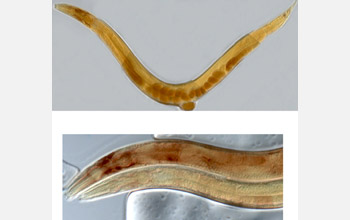Multimedia Gallery
Micrograph of Roundworm
A micrograph of a free-living roundworm (C. elegans).
Mark B. Roth, a cell biologist at the Fred Hutchinson Cancer Research Center, used nematodes (garden worms) and yeast to study the phenomenon of suspended animation--the temporary suspension of vital functions, such as when an individual drowns. Findings from their work may help explain the mechanics of the phenomena.
Roth and his team found that the model organisms can survive hypothermia or potentially lethal cold, if they are put into a state of suspended animation first by means of anoxia, or extreme oxygen deprivation.
Working in the lab, Roth and colleagues found that under normal conditions, the yeast and nematode embryos did not survive extreme cold. After being exposed to temperatures just above freezing for a 24-hour period, 99 percent of the creatures had expired. But, the researchers found that if the organisms were first deprived of oxygen, causing them to enter a state of anoxia-induced suspended animation, then 66 percent of the yeast and 97 percent of the nematode embryos survived the cold. And, when normal growth conditions were resumed, and the organisms rewarmed and oxygen reintroduced, they reanimated and went on to live normal lifespans.
Roth believes if we gain a better understanding of the symbiotic relationship between low oxygen and low temperatures, it may lead to the development of improved techniques for preserving human organs for transplantation.
To read more about this research, see the Fred Hutchinson Cancer Research Center news release, "Freezing 'to death' and living to tell about it: Study reveals how suspended animation protects against lethal hypothermia." (Date of Image: 2009)
Credit: Tres Frazier
Images and other media in the National Science Foundation Multimedia Gallery are available for use in print and electronic material by NSF employees, members of the media, university staff, teachers and the general public. All media in the gallery are intended for personal, educational and nonprofit/non-commercial use only.
Images credited to the National Science Foundation, a federal agency, are in the public domain. The images were created by employees of the United States Government as part of their official duties or prepared by contractors as "works for hire" for NSF. You may freely use NSF-credited images and, at your discretion, credit NSF with a "Courtesy: National Science Foundation" notation.
Additional information about general usage can be found in Conditions.
Also Available:
Download the high-resolution TIF version of the image. (689 KB)
Use your mouse to right-click (Mac users may need to Ctrl-click) the link above and choose the option that will save the file or target to your computer.

